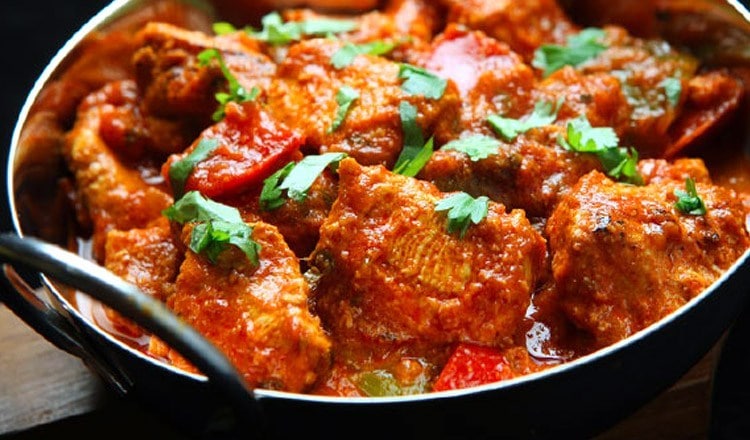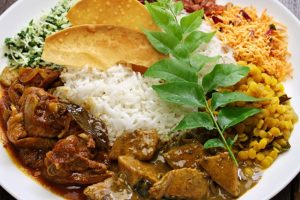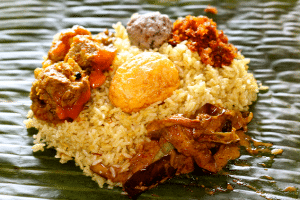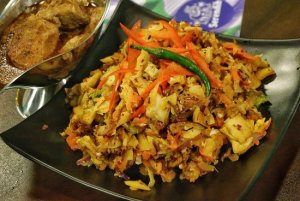Sri Lankan Cuisines and Tasty Sri Lankan Foods

Sri Lankan Cuisines and Tasty Sri Lankan Foods
Sri Lanka boasts a unique culinary heritage of a fusion of traditional dishes with recipes and cooking techniques brought to the island by traders and colonialists. Sri Lankan cuisine has been shaped by many historical, cultural and other factors. Sri Lankan food is unique for their Culture. Many Sinhala food items are derived from Chena cultivation. Sri Lankan cuisine plays a vital role in the islanders’ life from the most auspicious Sinhala/ Hindu New Year to normal day-to-day practices. They make milk rice and special sweets with coconut milk, floor and Honey at cultural festivals. It is recognized as one of the sixty- four types of art, “Siu Seta kalawa”. The curries come in many verities of colours and flavours blended in Sri Lankan Hot Spices has a great ayurvedic value when used in curries. “Lunu dehi” (lime pickle) and jaadi (Pikled fish) are food items made from methods of preserving since they could dry them in sun during rainless days. Staple diet of Sri Lanka is ‘Rice and curry’ the word ‘curry’ convering a multitude of dishes which are made according to different methods of cooking from Soups, meat, Sea food, Lentils, Vegetables, Sambols, Mallums, Phies to Achcharus.
Main Dishes
Rice and Curry

There’s nothing more common to eat as Sri Lankan food than a nutritious plate of rice and curry. You normally get a plate of rice piled with a few of the daily vegetable curries and a choice of fish curry as well. The central feature of Sri Lankan cuisine is boiled or steamed rice, served with a curry of fish, chicken or mutton, along with other curries made with vegetables, lentils, or fruits. Dishes are accompanied by pickled fruits or vegetables, chutneys, and sambols. Coconut sambol is especially common, a paste of ground coconut mixed with chili peppers, dried Maldive fish, and lime juice. Rice is the staple food of the Sri Lankans. Almost every household in Sri Lanka takes rice and curry as its main meal. Meat, fish and vegetables are prepared as curries. Sliced onions, green chilies, black pepper, cinnamon, cardamom, cloves, nutmeg and saffron are used to add flavours. A basic rice and curry requires one fish (or beef or chicken) curry, two different vegetables, one portion of fried crispy stuff like ‘papadam’, a ‘mallum’ of chopped leaves and coconut, and a gravy or ‘hodda’ of spiced and cooked with coconut milk.
Kiribath (Milk Rice)
Milk rice or Kiribath is a traditional Sri Lankan dish made from rice. Kiribath (milk rice) is rice cooked in salted coconut milk until the grains turn soft and porridge-like. It is a popular festive dish or any auspicious moment. The dish is prepared by cooking rice with coconut milk, hence this name. Generally eaten for breakfast, kiribath is also prepared on special occasions such as birthdays, New Years’ and religious festivals. It is usually served with lunu miris, a relish made with red onions and chillies. During Aluth Avurudu/Puthandu, the Sinhalese/Tamil New Year, kiribath is served with sweets such as Kavum, Kokis, Mung kavum.
Lamprais

Lampreis, the diva of Sri Lankan rice and curry is a dish of rice cooked in stock, combined with a variety of mouth-watering local curries. Sri Lanka has been influenced by a diversity of cultures and one of the most evident is the Dutch Burgher community. Lamprais, a word that combines the two Dutch words for “lump” and “rice,” is a combination of meat, rice and sambol chili sauce, wrapped into a banana leaf packet and steamed. The rice is cooked with meat stock — usually a combination of different meats like beef, pork or lamb — that’s infused with cardamom, clove and cinnamon. A scoop of rice is placed in the centre of a banana leaf, along with the mixed meat curry, two frikkadels (Dutch-style beef balls), blachan (a shrimp paste) and a starch or vegetable, usually either ash plantain or brinjals. The package is folded into a parcel and steamed. Since lamprais is a Burgher contribution to Sri Lankan cuisine, the meat is usually prepared with sweet spices like clove and cinnamon, recreating the flavour favoured by the Dutch Burgher community. Original recipes called for beef, pork and lamb, but chicken and eggs are often included in a modern lamprais pack.
Pittu
Pittu is made by steaming a mixture of grated coconut and rice flour in a bamboo mould. The steamy, soft, crumbly Pittu has the most enticing aroma and is best eaten with fresh coconut milk, lunu-miris and local meat curry. Pittu is a popular and frequently prepared food item among Sri Lankans, both Tamils living in Northern and Eastern parts of Sri Lanka as well as Sinhalese living in the rest of the areas of the country. Traditionally the main ingredient of “Pittu” is rice flour, but kurakkan flour or wheat flour also can be used. Pittu are cylinders of steamed rice mixed with grated coconut.
Roti
Gothamba roti is a simple Sri Lankan flatbread usually made from wheat floor. Variants of roti include thengappu roti (Pol in Sinhalese), in which shredded coconut is mixed into the dough. Another variant is Uraippu roti (spicy roti), in which chopped onions and green chilies are used when making the dough. Roti is a quick meal- and easy to prepare. Wheat, rice or kurakkan (Eleusine coracana, a strongly flavoured brown millet)-meal is mixed with fresh grated coconut and a touch of oil and baked on a hot griddle in thin flat cakes. Roti is equally good with chilly relish or with syrup. Shallots, green chillies, curry leaves and Maldive (cured) fish flakes are asked to ring in the changes. In Sri Lanka also have koththu roti and Gothamba roti as well.
Sambol
Sambols are enjoyed with many dishes including curry dishes and string hoppers. Sini sambol, Pol Sambol, Lunu miris and Vaalai kai sambol are common sambols found in the country. Sambols, freshly prepared, usually uncooked condiments are an integral part of every meal in Sri Lanka, and there is no sambol as popular as pol sambol. Pol is the Sinhalese word for coconut, and this sambol puts the island nation’s most ubiquitous ingredient to excellent use. Freshly grated coconut is pounded, usually in a stone mortar and pestle, with red onion, dried chili flakes, salt, and lime juice. The lime juice moistens the shredded coconut and adds a bright tanginess to this spicy sambol. Occasionally, you might also find flakes of Maldive fish (dried and cured tuna flakes) in your pol sambol. Traditionally produced in the Maldives, Maldive fish adds a distinct umami depth to many Sri Lankan dishes. As far as condiments go, pol sambol is a versatile one, pairing perfectly with a variety of carbs. I like it best for breakfast, scooped up with a hopper or adding a little jolt of spice to pol rotti, rustic flatbreads made of refined flour and grated coconut. In Sri Lanka, pol sambol is used as a garnish or side dish for everything and anything.
Malay Achcharu (Malay Pickle)
Malay Achcharu also known as Sri Lankan Malay pickle is a dish that originated from the Local Malay Community and is now widely popular among all ethnic groups in the country. It is a selection of veggies in a pickled sauce and blends sweet, sour and spicy flavours.
Abultheyal
Malu Ambulthiyal a unique spicy fish preparation with thick gamboges ‘Goraka’ paste. This is a very popular dish of a fish steak (usually an oily fish like kingfish) in a sour curry sauce. Sri Lanka has a great selection of delicious fish. That intense pucker is the hallmark of a good ambul thiyal, or sour fish curry, a specialty of southern Sri Lanka. Although you will find several kinds of fish curry in the seafood-loving country ranging from fiery to mild and creamy ambul thiyal is utterly unique. The ambul, or sourness, comes from a star ingredient sour tropical fruit called goraka, or Malabar tamarind, which lends the curry its characteristic sharpness and deep colour. Originally developed as a rustic way to preserve fish in the pre refrigeration era, ambul thiyal has become something of a delicacy in modern Sri Lanka. It may not feature very often in everyday meals, but that’s not surprising. A complex creation made from simple ingredients, it is the sort of dish that demands and deserves reverence. Originating in southern Sri Lanka, it’s available throughout the country at restaurants that serve curry, and is best eaten with rice.
Polos (green jackfruit curry)
Jackfruit is consumed in a number of different stages of ripeness, from very ripe and sweet to green and starchy. Polos is a Sri Lankan curry prepared with young green jackfruit. The fruit is sliced into bite-sized chunks and boiled until soft. It’s then cooked with onions, garlic, ginger and spices like mustard seeds, turmeric, chili powder, roasted curry powder, pandan leaves and curry leaf sprigs. The final step is to add coconut milk and simmer to reduce most of the liquid, leaving all the beautiful flavors within the cubes of jackfruit. Jackfruit has a starchy texture, somewhat similar to cassava or potato. Polos is a standard dish available at most Sri Lankan curry restaurants.
Sweets & Desserts
Sri Lankan desserts are very sweet. Jaggery – boiled and set palm syrup (kitul) – is the main sweetener. A common dessert in Sri Lanka is kevum an Oil Cake made with rice flour and treacle and deep-fried to a golden brown. There are many variations of kevum. Moong Kevum is a variant where mung bean flour is made into a paste and shaped like diamonds before frying. Other types of kevum include athiraha, konda kevum, athirasa, and handi kevum.
Aluwa
Diamond shaped rice-flour pastries.
Bibikkan
A rich, cake-like sweet made from grated coconut, coconut treacle, and wheat flour. It is a speciality of coastal areas.
Kokis
A savoury crispy biscuit-like dish made from rice flour and coconut milk.
Pushnambu
A rich, cake like sweet made from coconut treacle and wheat flour. Cinnamon/cardmom and sweet cumin is often added among the Christian population of Sri Lanka.
Seenakku
A glutinous rice cake often served with grated coconut.
Undu Walalu /Undu wal or Pani Walalu
A sweet from the Mathale area, prepared using urad bean flour and kithul treacle. Peni walalu or Unduwel is a very sweet food, especially in Sinhala & Tamil New Year Season Sri Lanka. Pani Walalu is a Deep Fried Coils of Urad dal & Rice Flour Mixture Soaked in Sugar Syrup.
Aggala
Rice balls flavoured with treacle.
Weli Thalapa
Made from rice flour and coconut treacle.
Aasmi
Made with rice flour and the juice of a leaf called Neolitsea cassia deep fried and topped with pink-coloured treacle.
Kalu Dodol
A solid toffee, jelly like confection made by lengthy reduction of coconut milk, thickened with rice flour and sweetened with jaggery.
Watalappan
A steamed pudding made with coconut milk, eggs, and jaggery. Watalappam has become a staple of Sri Lankan desserts. A tropical twist on a custard pudding, watalappan is the decadent legacy of Malay immigrants to Sri Lanka. The steamed pudding is made of coconut milk (occasionally combined with condensed milk), eggs, cashews, and jaggery (unrefined palm sugar), with cardamom and cloves for fragrance. Made right, watalappan has a springy texture and a caramel sweetness that pairs perfectly with the gentle flavor of coconut milk. In a country that favors cake over indigenous desserts, watalappan is an honorable exception.
Thala Guli
Made from ground sesame and jaggery with finely grated coconut.
Kiri Toffee
Made with sweetened condensed milk or sugar-thickened pure cow’s milk. Cardamom/sweet cumin and cashews are added for more taste.
Street Foods
Street vendors, usually preparing snacks such as vadai (a spicy, deep-fried lentil doughnut), can be commonly seen in Sri Lanka. There are also many roadside restaurants, mostly frequented by locals, where patrons can watch the food being prepared. Street food is a national treasure here in Sri Lanka. The fondness and love we put into making food with recipes that have been passed down generation after generation, has in no small way affected the very fabric of our everyday lives.
Kottu Roti

The King of Sri Lankan street food, an extremely popular Sri Lankan street food dish is known as kottu or kottu roti. Kothu roti is made from Gothamba roti and vegetables, eggs, or meat and various spices. It is a delicious meal generally eaten at dinner time. Apart from the commonest form of Kothu with meat, eggs or vegetables a newer variety with cheese has been introduced. The Gothamba roti is cut or chopped with the use of two metal blades on wooden handles held on both hands on this sheet or skillet. The clashing of metal blades and the skillet creates a very distinctive musical sound which kind of announces the making of this Kothu to the passersby. This can be made using Parotta and that is how this is made in South India where Parotta is popular as with Gothamba roti in Sri Lanka. The ingredients and method are the same as for Kothu roti using Gothamba roti. Kottu roti is sort of like the “hamburger” of Sri Lanka, something that’s so tasty, available as a fast meal, and it’s basically nearly impossible to resist. If vegetarian kottu is the hamburger of Sri Lanka, cheese kottu is the quadruple bacon cheeseburger. Yellow curry powder flavour is bumped up a few notches with cheese kottu and it’s a Sri Lankan food that you just can’t miss. The cheese is not traditional yellow cheese, but rather more like cottage milk cheese.
Achcharu (Pickles)
Achcharu is a very fond memory for every Sri Lankan who has the tangy, sweet taste of it etched into their minds thanks to their childhood. What the dish is unripe fruit pickled in a mixture of vinegar, sugar, salt and some chili powder. Often fruits used for Achcharu are mango, pineapple and ambarella but it is also made using olives.
Deep Fried Morsels
As you may have noticed by now, though there are many vegetarian dishes, Sri Lankan food is not all that healthy. On top of that, Sri Lanka is a country that loves their deep fried snacks. These snaky morsels of batter were heavily salty and seasoned with fried curry leaves.
Deep Fried Jackfruit Seeds
Another popular snack in Sri Lanka are deep fried jackfruit seeds. They are salted and served in small paper bags made from scrap paper. Some of the Sri Lankan street food carts and snacks even reminded me of Egyptian street food.
Uludu Wade
These marvelously tasty little fritters are made from daal, combined with incredible spices, and deep fried to crunchy perfection. Wade is a staple in any Sri Lankan street food connoisseur’s pantry. This savory doughnut type morsel is soft and doughy on the inside but crispy on the outside often times with onion and chili mixed into the batters before the fritters are fired to brown perfection. Often Uludu is eaten with coconut chutney that gives it an extra kick.
Parippu Wade
A distant cousin of Uludu Wade, Parippu wade is made out of crunchy lentils that have been deep friend in almost the identical manner as Uludu Wade. However, while the former is soft, Parippu Wade is much crispier and makes a distinct noise when bitten into. It has a taste all to its own and is quite addictive.
Cassava (Manioc) Chips
Made from the humble cassava, Manioc chips have been around in Sri Lanka for quite some time. The preparation is simple but the taste is so good, we’d still make it even if it were the hardest thing in the world to make. All you have to do is cut the chips into thin slices then deep dry until golden brown add some salt and chili and you have yourself a satisfying snack that will keep you munching for hours.
Egg Hoppers
Hoppers which are also known as appa, are an iconic food of Sri Lanka. Although there is no good time to indulge in street food most are consumed during the wee hours of the night. Not so with egg hoppers, although eaten at any time of the day for any meal this dish is most often served in the morning for breakfast. It is basically the Sri Lankan version of thin pancakes with crispy edges. Traditionally an egg is cracked over the bowl shaped pancake until it cooks. Often the dish is served with Lunu Miris – a sambol of onions, chili, lemon juice and salt.
Short Eats
The subject of short Eats in Sri Lanka could inspire a library of cookery books. Eaten anytime and at all times in bakeries, restaurants and humble food stall, short eats are so in demand that they are found anywhere in the country and are usually freshly made. From crisp fried crumbed rolls (Chinese rolls) to buns stuffed with fish. The range of Sri Lankan short eats is vast and extensive. Whenever big meals are too much to think about, order a plate of short eats and let your trouble melt away.



